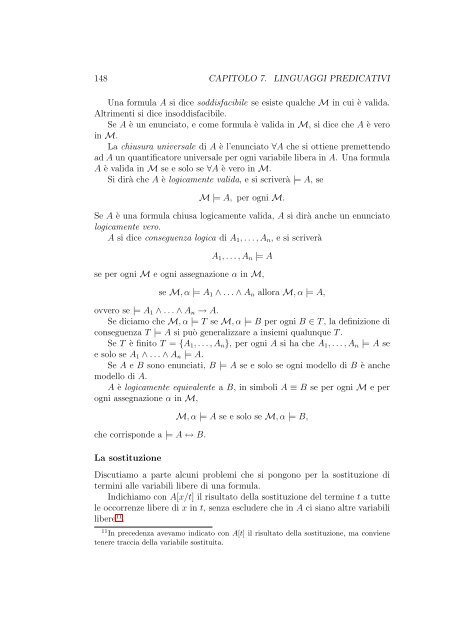Logica Matematica Corso di Laurea in Informatica ... - Mbox.dmi.unict.it
Logica Matematica Corso di Laurea in Informatica ... - Mbox.dmi.unict.it
Logica Matematica Corso di Laurea in Informatica ... - Mbox.dmi.unict.it
Create successful ePaper yourself
Turn your PDF publications into a flip-book with our unique Google optimized e-Paper software.
148 CAPITOLO 7. LINGUAGGI PREDICATIVI<br />
Una formula A si <strong>di</strong>ce sod<strong>di</strong>sfacibile se esiste qualche M <strong>in</strong> cui è valida.<br />
Altrimenti si <strong>di</strong>ce <strong>in</strong>sod<strong>di</strong>sfacibile.<br />
Se A è un enunciato, e come formula è valida <strong>in</strong> M, si <strong>di</strong>ce che A è vero<br />
<strong>in</strong> M.<br />
La chiusura universale <strong>di</strong> A è l’enunciato ∀A che si ottiene premettendo<br />
ad A un quantificatore universale per ogni variabile libera <strong>in</strong> A. Una formula<br />
A è valida <strong>in</strong> M se e solo se ∀A è vero <strong>in</strong> M.<br />
Si <strong>di</strong>rà che A è logicamente valida, e si scriverà |= A, se<br />
M |= A, per ogni M.<br />
Se A è una formula chiusa logicamente valida, A si <strong>di</strong>rà anche un enunciato<br />
logicamente vero.<br />
A si <strong>di</strong>ce conseguenza logica <strong>di</strong> A1, . . . , An, e si scriverà<br />
A1, . . . , An |= A<br />
se per ogni M e ogni assegnazione α <strong>in</strong> M,<br />
se M, α |= A1 ∧ . . . ∧ An allora M, α |= A,<br />
ovvero se |= A1 ∧ . . . ∧ An → A.<br />
Se <strong>di</strong>ciamo che M, α |= T se M, α |= B per ogni B ∈ T , la def<strong>in</strong>izione <strong>di</strong><br />
conseguenza T |= A si può generalizzare a <strong>in</strong>siemi qualunque T .<br />
Se T è f<strong>in</strong><strong>it</strong>o T = {A1, . . . , An}, per ogni A si ha che A1, . . . , An |= A se<br />
e solo se A1 ∧ . . . ∧ An |= A.<br />
Se A e B sono enunciati, B |= A se e solo se ogni modello <strong>di</strong> B è anche<br />
modello <strong>di</strong> A.<br />
A è logicamente equivalente a B, <strong>in</strong> simboli A ≡ B se per ogni M e per<br />
ogni assegnazione α <strong>in</strong> M,<br />
che corrisponde a |= A ↔ B.<br />
La sost<strong>it</strong>uzione<br />
M, α |= A se e solo se M, α |= B,<br />
Discutiamo a parte alcuni problemi che si pongono per la sost<strong>it</strong>uzione <strong>di</strong><br />
term<strong>in</strong>i alle variabili libere <strong>di</strong> una formula.<br />
In<strong>di</strong>chiamo con A[x/t] il risultato della sost<strong>it</strong>uzione del term<strong>in</strong>e t a tutte<br />
le occorrenze libere <strong>di</strong> x <strong>in</strong> t, senza escludere che <strong>in</strong> A ci siano altre variabili<br />
libere 11 .<br />
11 In precedenza avevamo <strong>in</strong><strong>di</strong>cato con A[t] il risultato della sost<strong>it</strong>uzione, ma conviene<br />
tenere traccia della variabile sost<strong>it</strong>u<strong>it</strong>a.




![Introduzione ai sistemi Wiki [PDF] - Mbox.dmi.unict.it](https://img.yumpu.com/16413205/1/184x260/introduzione-ai-sistemi-wiki-pdf-mboxdmiunictit.jpg?quality=85)











